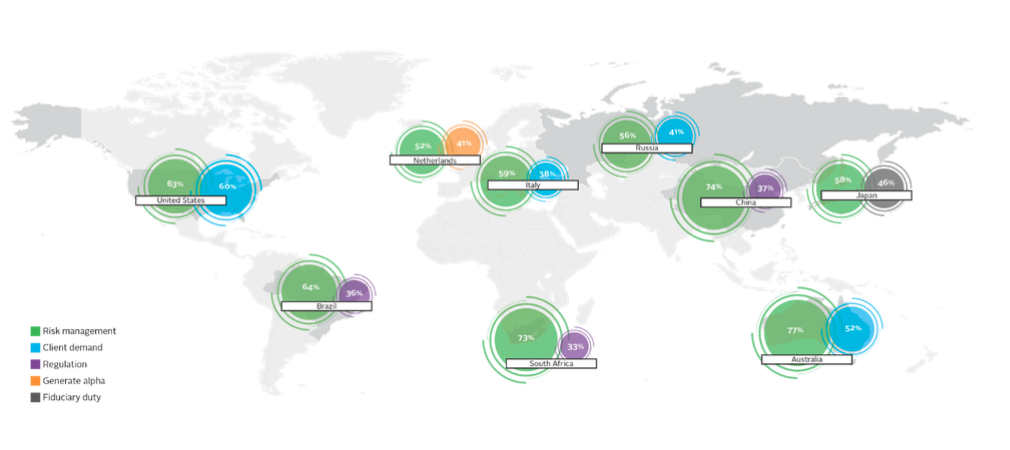Asset Owners Experience Shortage of ESG Products Meeting Expectation
Summary points
- Clients have the power to drive ESG integration forward as practitioners listen to them. Two obstacles remain, however: (1) client demand and ESG supply, and (2) guidance on asset owner’s expectations.
- Although ESG integration is being demanded and ESG products are being offered, current demand still is outweighing supply.
- Asset owners will adapt their assessments of investment managers, factoring in their asset class, investment styles, and even the willingness of investment managers to develop their ESG knowledge and expertise over time.
Across the 17 markets where CFA Institute and Principles for Responsible Investment (PRI) held environmental, social, and governance (ESG) integration workshops, we discovered that risk management was the largest driver of ESG integration for equity investments and fixed-income investments. The second largest driver was client demand, which was a top-two driver across 11 of 17 jurisdictions for equity investments and 15 of 17 jurisdictions for fixed income (see Exhibits 1 and 2).
Clients have the power to drive ESG integration forward as practitioners listen to them. Two obstacles remain, however: (1) client demand and ESG supply and (2) guidance on asset owner’s expectations.


Client demand and ESG supply
Currently, a lot of noise is being made in the market and by the media about the strong momentum behind ESG investing. Since CFA Institute and PRI embarked on our joint global ESG integration study in May 2017, we have noticed an acceleration in the number of portfolio managers and analysts who genuinely are interested in ESG integration. They also want to understand how their peers are implementing ESG investing into their firms’ investment philosophy, process, strategies, and portfolios.
Workshop participants at the Frankfurt workshop supported this market trend and said ESG integration does not seem to be a fashion or a fad. They observed that institutional clients are driving Germany’s ESG demand. Institutional demand also has driven the focus to be on value and ESG integration rather than on clients’ values and screening.
Despite the rising institutional demand, asset owners are experiencing supply shortages. Participants at the Paris workshop agreed that although ESG integration is being demanded and ESG products are being offered, current demand still is outweighing supply. This issue was raised across many jurisdictions, including in India, where participants noted that the investment industry has a small supply of ESG products that do not cater to the investors who are seeking them.
Guidance on asset owner’s expectation
Another factor that is limiting asset owners’ uptake of ESG products is the creation of ESG products that do not meet their expectations and criteria. Investment managers are struggling to understand exactly what asset owners want. Part of this problem is a lack of understanding of ESG investing, which is detailed in a blog post on “Four Areas of Misunderstanding Around ESG Integration.” In this blog post, we highlighted the widely held misconception that ESG integration means sacrificing performance because many believe that ESG integration prohibits investments in certain sectors and companies.
Investment managers are keen to understand what asset owners are seeking. We discovered that many workshop participants just wanted us to tell them “how” to best integrate ESG data in the investment practice. This might sound like a cop-out, but unfortunately, no one approach can work for everyone in every case. Consider the following variables:
- Asset owner have varied levels of understanding about ESG investing and hold different investment beliefs and strategies; they also may have different motivations behind pursuing ESG investing, such as whether it is for value, values, or impact or they may have a combination of the three. In addition, asset owners have varying budgets and headcount, which can widen or limit what they can do.
- Investment managers also have different investment beliefs and strategies, understanding, and motivations. In addition, their client base will have different expectations and preferences and investment managers have to contend with these differences.
- Within asset owners and investment managers, portfolio managers have different styles — value, growth, market capitalization, discretionary versus rules-based approaches, global markets versus developed markets versus emerging markets — that lend themselves to or prevent them from adopting certain approaches and techniques to integrate ESG factors.
On the whole, asset owners do understand that investment managers have constraints as well as favored techniques in regards to ESG integration. Rob Wilson, a research analyst at MFS Investment Management, explains, “When I talk to clients, I have found that they understand integrating ESG factors is not an easy process and requires different approaches depending on the manager’s investment philosophy, asset class, and other factors. I’m not sure a lot of managers appreciate how understanding asset owners are and that in the vast majority of cases they want to have an open dialogue about the challenges that their managers are facing in regards to integrating ESG issues into their analysis. We’ve learned a great deal — and have provided some valuable perspective as well — by openly and honestly collaborating with our clients.”
Asset owners who have been in the game for a while will not take a blanket approach to manager selection and monitoring, but they will adapt their assessments to investment styles and asset classes and even to the willingness of new investment managers to develop their ESG knowledge and expertise over time. They do expect, however, their investment managers to fully embed ESG investing into their strategies and processes. Investment managers need to believe in ESG and fully integrate it into their investment philosophy. Asset owners are skeptical of investment managers who bolt-on ESG to their investment processes or simply add an ESG layer to their existing funds because those investment managers are perceived to be chasing the assets rather than actively seeking the risk–return benefits of true ESG integration.
Michael Marshall, director of Responsible Investment and Engagement at asset owner LGPS Central Limited, reveals that
sometimes you get responses to tender that says, “when it comes to ESG, we can do what you want, we can tailor what we do to the client.” To me, that suggests they’re running a strategy where they don’t fully believe in ESG and don’t see it as a core part of their investment process. We’re not that invested in that kind of approach.
Training is the solution
The creation of ESG products that don’t meet asset owners’ expectations is also caused by asset owners not being clear about what they actually want. Some investment managers get a sense that asset owners are not quite sure what they’re looking for. Even investment managers with a long track record in ESG investing would like greater communication and transparency from asset owners about what they want.
To resolve this issue, leading ESG asset owners and investment managers are providing cross-training. Asset owners provide training to their legacy managers and new portfolio managers, covering areas such as policy, processes, data, and ways to collaborate. Masja Zandbergen-Albers, head of ESG integration at Robeco, explains that at her investment management firm, “We tend to spend quite a lot of time being an advocate for sustainability investing. We pass on knowledge to potential clients so they understand what sustainability is about and we form partnerships with clients to provide formal education and develop investment solutions.”
Hard work brings rewards
The ESG industry is excited by the upsurge in momentum for ESG investing, but wary that this creates an opportunity for “greenwashing” to win assets under management. Asset owners are cognizant of this possibility and have developed strong manager selection, appointment, and monitoring processes to identify it. At LGPS Central Limited, Marshall explains that they have a three-stage selection process: stage 1 is a prequalification questionnaire, stage 2 is the request for proposal (RFP), and stage 3 is face-to-face management interviews. Within the RFP, they ask for specific examples of how ESG factors are integrated into stock evaluations.
Marshall outlines his team’s process during face-to-face interviews:
We meet the portfolio manager and the ESG person, if there is one. We’re not looking for the ESG person to answer every question on ESG by themselves. We’re looking for the managers to speak for themselves. We want time with the manager where the ESG person is not in the room. We want to make sure the decision maker is fully conversant in these issues and understands the process and that the process hasn’t just been outsourced or that the managers haven’t just had a consultant come in and write it for them or told the sales person what they need to say. We sometimes walk the floor and go and talk to other analysts to make sure that if they’ve got a particular ESG process that makes its way into the investment thesis, the analysts for a particular sector or stock know what this rating is, how it’s constructed, and what it means.
Although this seems like a lot of hard work, it brings rewards. Increasing numbers of asset owners are asking for ESG products. Once there is better understanding and greater transparency around asset owner’s expectations, this will increase the momentum exponentially with even higher demand for ESG products that can meet these expectations.
Image credit: ©d3sign

